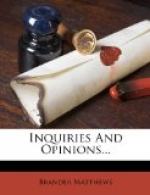Thackeray was frequent in praise of Fenimore Cooper, hailing Leatherstocking as better than any of “Scott’s lot”; and this laudation appeared in the ‘Roundabout Papers’ long after the British novelist had paid to the American romancer the sincere flattery of borrowing from the last words of Natty Bumppo the suggestion, at least, of the last words of Colonel Newcome. Cooper’s backwoodsman, hearing an inaudible roll-call had responded “Here!” a score of years before Thackeray’s old soldier had become again a child to answer “Adsum!” Not less than a score of years later an old sailor in one of the stories of Sir Walter Besant made his final exit from this world with a kindred phrase, “Come on board, sir!” And then, once more, in one of Mr. Kipling’s ’Plain Tales from the Hills,’ we find the last dying speech and confession of a certain McIntosh who had been a scholar and a gentleman in days gone by, and who had sunk into irredeemable degradation in India. When his hour came, he rose in bed and said, as loudly as slowly, “Not guilty, my Lord!” Then he fell back, and the stupor held him till he died.
There are criticasters not a few who would denounce Thackeray and Besant and Mr. Kipling as arrant plagiarists; but critics of a more delicate perception of the principles of art would rather praise these authors for the ingenuity with which they had successively made use of Cooper’s original device. Indeed, the more delicate the perceptions of the critic the less likely would he be to assert positively that all four authors had not hit on the same effect independently. Thackeray may have taken it over from Cooper, consciously or unconsciously; Besant may have borrowed it from either his British or his American predecessor; and Kipling may have been familiar with it in the pages of Cooper, of Thackeray, and of Besant, and still have found amusement in giving a new twist to an old trick. But it is perfectly possible that we have here an instance of purely accidental similarity, such as keen-eyed readers can discover abundantly in the highways and byways of literary history.
The theme of M. Paul Bourget’s ‘Andre Cornelis’ is that of ‘Hamlet,’ but in all probability the French novelist was not aware that he was treading in the footsteps of the English dramatist until his own plot had taken shape in his mind. A situation in ’Vanity Fair’—that of Dobbin in love with the widowed Amelia and yet unwilling to break down her belief in her dead husband’s fidelity—was utilized in the ‘Henrietta’ of Mr. Bronson Howard, who was characteristically scrupulous in recording on the playbill his indebtedness to Thackeray’s novel; and this same situation at about the same time had been utilized also in a little one-act play, ‘This Picture and That,’ by an author who had never doubted it to be of his own invention (altho he had read ‘Vanity Fair’ more than once), and who did not discover how he had exposed himself to the accusation of plagiarism until he happened to see the ‘Henrietta’ acted, and to perceive the full significance of Mr. Howard’s memorandum.




